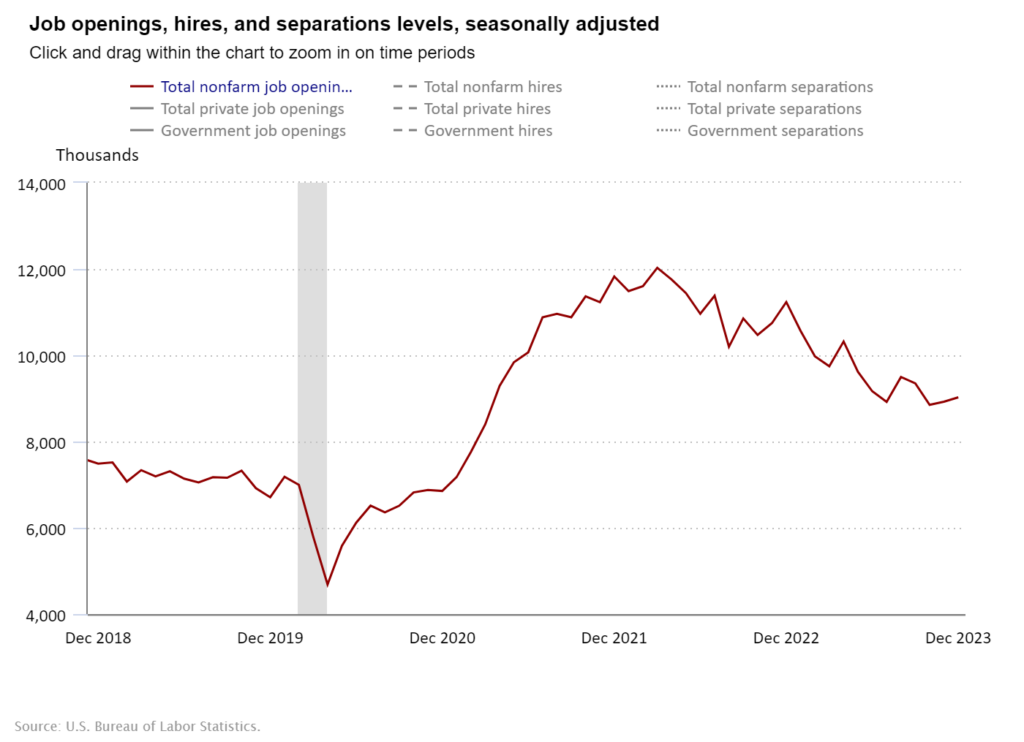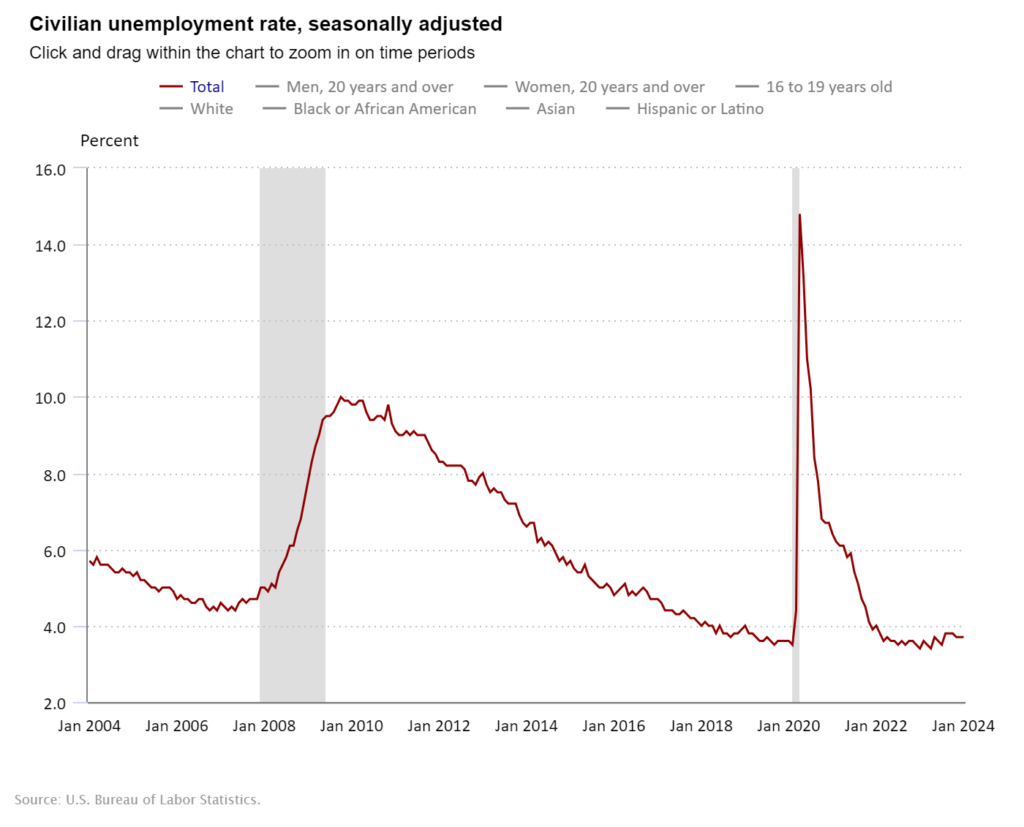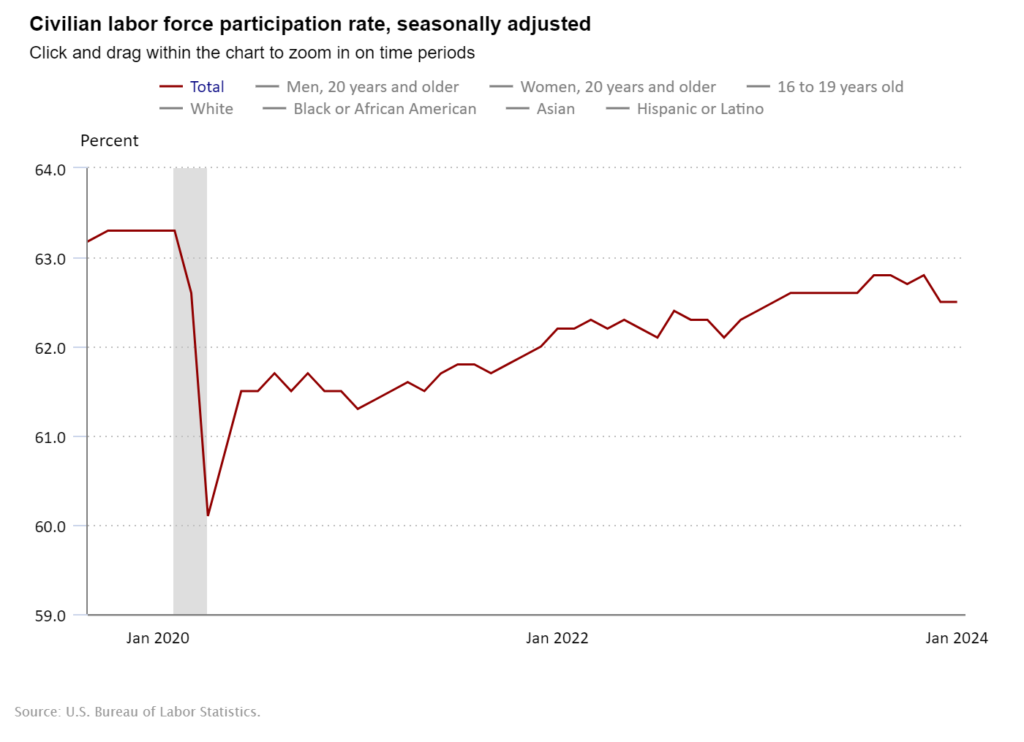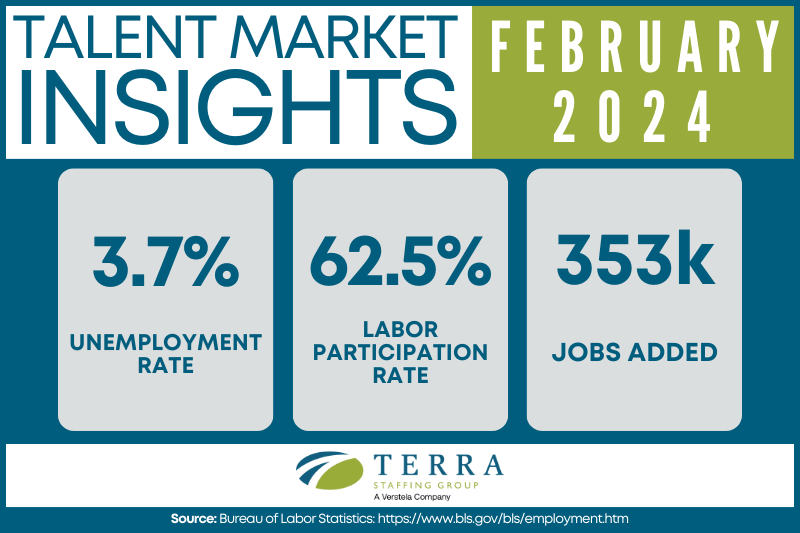February 2024 Talent Market Insights
Posted on February 14, 2024
January was a robust month for job growth—with job gains reminiscent of pre-pandemic levels typical for the first month of the year.
The economy remains stronger than ever. People have continued to spend. And the Feds have held interest rates steady again.
We’ll discuss what’s going on in the labor market and what this means for employers.
Key takeaways:
- 353,000 jobs were added in January, which is now the 37th consecutive month of job gains.
- Wage growth increased by 0.6%—potentially due to minimum wage increases taking effect.
- The unemployment rate has remained under 4% for 24 months straight.
Number of Jobs Available

January has shown an outstanding start to 2024. Job gains for December and November 2023 have also been adjusted upward. December’s job gains grew by 117,000 to 330,000. And November’s job gains increased by 9,000 to 182,000.
Leading industries in job growth include business services (74,000), healthcare (70,000) and retail trade (45,000). These high numbers can be attributed to the start of the new year. Employers may be leveraging January, when people are more likely to search for a new job.
The latest JOLTS report showed that job openings changed little, at 9 million on the last day of December, which is the first-time job openings increased above 9 million since September.
The U.S. economy remains exceptionally strong. And while January’s job gains may appear to be a significant dip when compared to January 2022 and January 2023’s extremely high numbers, this January is a noticeable return to pre-pandemic levels.
Unemployment

The unemployment rate remained unchanged at 3.7% for the third month in a row. The number of unemployed people changed little at 6.1 million. And in the latest JOLTS report, the number of quits dropped to 3.4 million, showing more evidence of The Big Stay.
Interestingly, it was pointed out that the unemployment rate has remained under 4% for 24 months straight, the first time since 1967.
And while the unemployment rate is low and there are plenty of new jobs being created, the high numbers of mass layoffs in January highlight differences in hiring strength across industries.
In January, more than 80,000 American workers were laid off, mostly affecting office workers, evidence that job security within business and professional services is wavering. WFH employees in particular may be more likely to get cut than in-office or hybrid workers, as managers are more reluctant to lay off people they have face-to-face interaction with.
It’s being reported that this was one of the largest months for layoffs in almost 15 years (not including the pandemic).
Workforce Participation

Workforce participation is relatively stagnant, remaining unchanged at 62.5%.
The employment population ratio was unchanged at 60.2%, the number people employed part time for economic reasons changed little at 4.4 million, and the number of people not in the labor force who want a job also changed little, at 5.8 million.
Some are viewing the lack of change in workforce participation as a sign of the new phenomenon, The Big Stay. Overall, employees are staying put—likely a result of 11 rate hikes last year, the cost of goods remaining above pre-pandemic levels and headline-making mass layoffs.
Wage Growth
Hourly earnings increased by 0.6%, which is double the monthly estimate. And over the year, wages increased 4.5%, above the 4.1% forecast.
This jump could be attributed to minimum wage increases and annual raises taking effect.
Wage growth, while great for workers, is not a positive sign for inflation. Feds will be paying close attention to wage growth to inform their decision around interest rates in their effort to cool inflation.
Winning Moves for Employers
Regardless of what’s happening in the economy, the companies with the best talent win.
Here are some effective strategies to maintain a competitive edge:
- Stay attractive to talent. Ensure your pay and benefits are equitable and in line with industry benchmarks. Offer training, growth, and unique perks to both attract and retain employees.
- Build trust amidst uncertainty. As we enter the era of The Big Stay, people are seeking reassurance, stability and growth opportunities. Effectively communicate your company’s mission, goals, and strategies. Share details about the current and future state of the company. These practices not only foster a sense of security but also promote employee engagement and productivity.
- Foster a supportive workplace culture. Attracting quality talent is important, but equally as important is ensuring current employees feel supported, valued and heard. Demonstrate a commitment to employee well-being, find opportunities to recognize performers and provide tools and resources to ensure all employees are set up for success.
- Consider temporary staffing. In any market, temporary staffing is a flexible, budget-friendly solution for businesses. It allows companies to navigate fluctuations in staffing demands, meet project deadlines, and meet productivity goals.
If you’re looking for more resources, be sure to check out our employer resource center. We have an archive of on-demand HR webinars, tools and articles to help you navigate various workplace challenges.
Feel free to contact us for insights into market trends and help with your staffing needs.
Categories: Staffing Tips & Recruiting Trends
Tags: job market data, labor market trends, Talent Market Insights, Talent Market Insights February 2024





